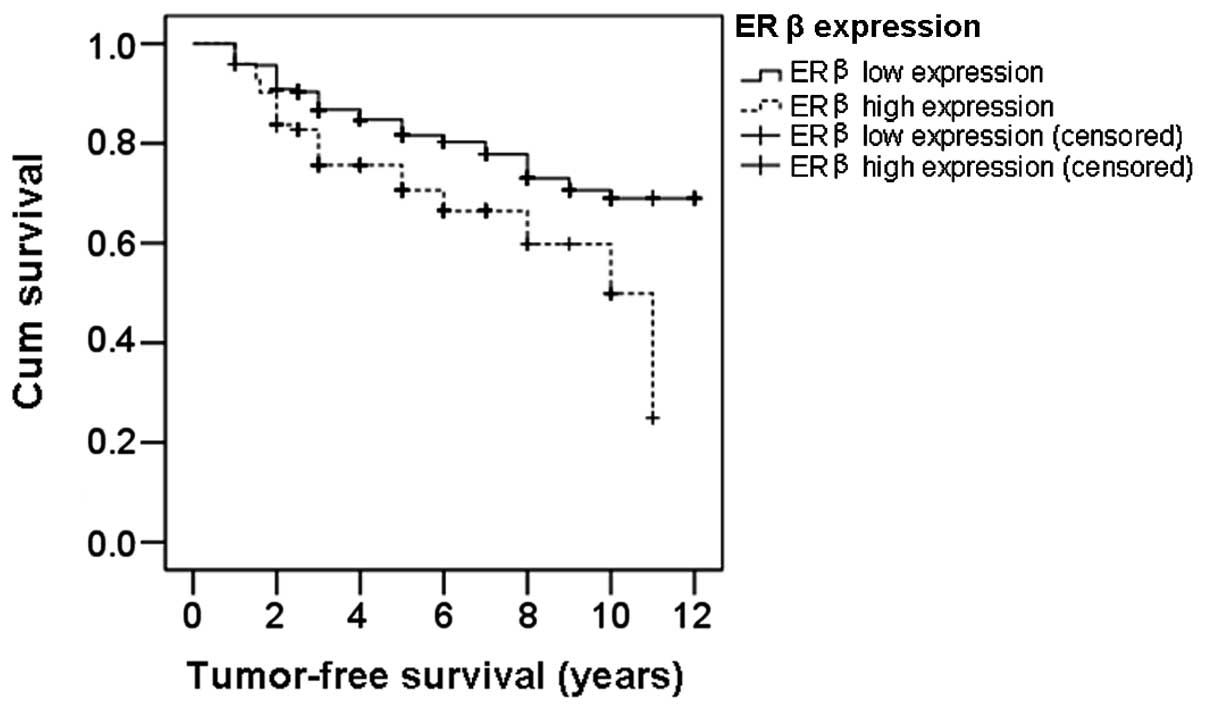Correlation between estrogen receptor β expression and the curative effect of endocrine therapy in breast cancer patients
- Authors:
- Liying Guo
- Yu Zhang
- Wei Zhang
- Dilimina Yilamu
-
View Affiliations
Affiliations: Department of Breast Cancer, Digestive and Vascular Center, The First Affiliated Hospital of Xinjiang Medical University, Urumqi, Xinjiang 830054, P.R. China, Department of General Surgery, Yantai Affiliated Hospital of Binzhou Medical University, Yantai, Shandong 264100, P.R. China, Department of Pathology, The First Affiliated Hospital of Xinjiang Medical University, Urumqi, Xinjiang 830054, P.R. China
- Published online on: March 27, 2014 https://doi.org/10.3892/etm.2014.1634
-
Pages:
1568-1572
Metrics:
Total
Views: 0 (Spandidos Publications: | PMC Statistics:
)
Metrics:
Total PDF Downloads: 0 (Spandidos Publications: | PMC Statistics:
)
This article is mentioned in:
Abstract
The aim of the present study was to investigate the association between the expression levels of estrogen receptor (ER)β and the curative effect of endocrine therapy in breast cancer patients. Cancer tissues were collected from 583 breast cancer patients between January 2000 and December 2010 and used for analysis. ERβ expression levels were determined using immunohistochemical staining. The Kaplan‑Meier method was used for survival analysis and the log‑rank test was conducted for difference analysis between survival times. In addition, Cox multivariate analysis was performed to analyze prognostic factors for breast cancer. In the immunohistochemical staining assay, a positive ERβ expression rate of <10% was defined as ERβ low expression, while >10% was defined as ERβ high expression. In patients expressing low levels of ERβ, the median tumor‑free survival time of the patients who received endocrine therapy was significantly higher compared with that of the patients who did not receive endocrine therapy. By contrast, in patients with high ERβ expression levels, there was no significant difference in the median tumor‑free survival time between the patients who received endocrine therapy and those who did not. In addition, compared with ERβ low expression patients, ERβ high expression patients had a significantly lower median tumor‑free survival time. Furthermore, ERβ expression, human epidermal growth factor receptor 2 expression, tumor size, lymph node metastasis, postoperative chemotherapy, radiotherapy and endocrine therapy were identified to be independent prognostic factors for breast cancer. Therefore, high ERβ expression in breast cancer indicates poor prognosis for endocrine therapy.
View References
|
1
|
Kuiper GG, Enmark E, Pelto-Huikko M, et
al: Cloning of a novel receptor expressed in rat prostate and
ovary. Proc Natl Acad Sci USA. 93:5925–5930. 1996. View Article : Google Scholar : PubMed/NCBI
|
|
2
|
Yuan MQ, Ping GF and Nan KJ: Progress in
research of estrogen receptor beta and primary liver cancer. Xian
Dai Zhong Liu Yi Xue. 16:1826–1829. 2008.(In Chinese).
|
|
3
|
Yager JD and Davidson NE: Estrogen
carcinogenesis in breast cancer. New Engl J Med. 354:270–282. 2006.
View Article : Google Scholar : PubMed/NCBI
|
|
4
|
Esslimani-Sahla M, Simony-Lafontaine J,
Kramar A, et al: Estrogen receptor beta (ERbeta) level not its ER
beta cx variant helps to predict tamoxifen resistance in breast
cancer. Clin Cancer Res. 10:5769–5776. 2004. View Article : Google Scholar : PubMed/NCBI
|
|
5
|
Hopp TA, Weiss HL, Parra IS, et al: Low
levels of estrogen receptor beta protein predict resistance to
tomoxifen therapy in breast cancer. Clin Cancer Res. 10:7490–7499.
2004. View Article : Google Scholar : PubMed/NCBI
|
|
6
|
Borgquist S, Holm C, Stendahl M, et al:
Oestrogen receptors alpha and beta show different associations to
clinicopathological parameters and their co-expression might
predict a better response to endocrine treatment in breast cancer.
J Clin Pathol. 61:197–203. 2008. View Article : Google Scholar
|
|
7
|
Lee H and Bai W: Regulation of estrogen
receptor nuclear export by ligand-induced and p38-mediated receptor
phosphorylation. Mol Cell Biol. 22:5835–5845. 2002. View Article : Google Scholar : PubMed/NCBI
|
|
8
|
Pettersson K and Gustafsson JA: Role of
estrogen receptor beta in estrogen action. Annu Rev Physiol.
63:165–192. 2001. View Article : Google Scholar : PubMed/NCBI
|
|
9
|
Osborne CK and Schiff R: Estrogen-receptor
biology: continuing progress and therapeutic implications. J Clin
Oncol. 23:1616–1622. 2005. View Article : Google Scholar : PubMed/NCBI
|
|
10
|
Chung YL, Sheu ML, Yang SC, et al:
Resistance to tamoxifen-induced apoptosis is associated with direct
interaction between Her-2/neu and cell membrane estrogen receptor
in breast cancer. Int J Cancer. 97:306–312. 2002. View Article : Google Scholar : PubMed/NCBI
|
|
11
|
Jensen EV, Cheng G, Palmieri C, et al:
Estrogen receptors and proliferation markers in primary and
recurrent breast cancer. Proc Natl Acad Sci USA. 98:15197–15202.
2001. View Article : Google Scholar : PubMed/NCBI
|
|
12
|
Razandi M, Pedram A and Levin ER: Plasma
membrane estrogen receptors signal to antiapoptosis in breast
cancer. Mol Endocrinol. 14:1434–1447. 2000. View Article : Google Scholar : PubMed/NCBI
|
|
13
|
Sun H, Zhang J, Zhan ZG and Hao XS:
Estrogen receptor β and related genes of its signaling pathway in
development of different models of breast cancer. Zhonghua Shi Yan
Wai Ke Za Zhi. 23:1422–1423. 2006.(In Chinese).
|
|
14
|
Yang SE and Li X: Expression and
significance of ERβ and HER2 in breast cancer. Zhonghua Zhong Liu
Za Zhi. 29:767–768. 2007.(In Chinese).
|













